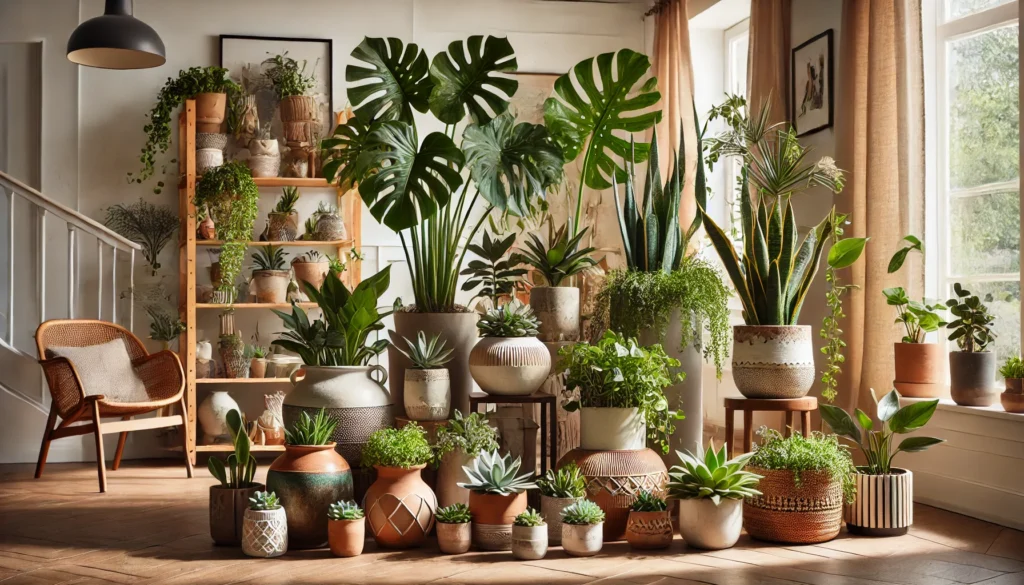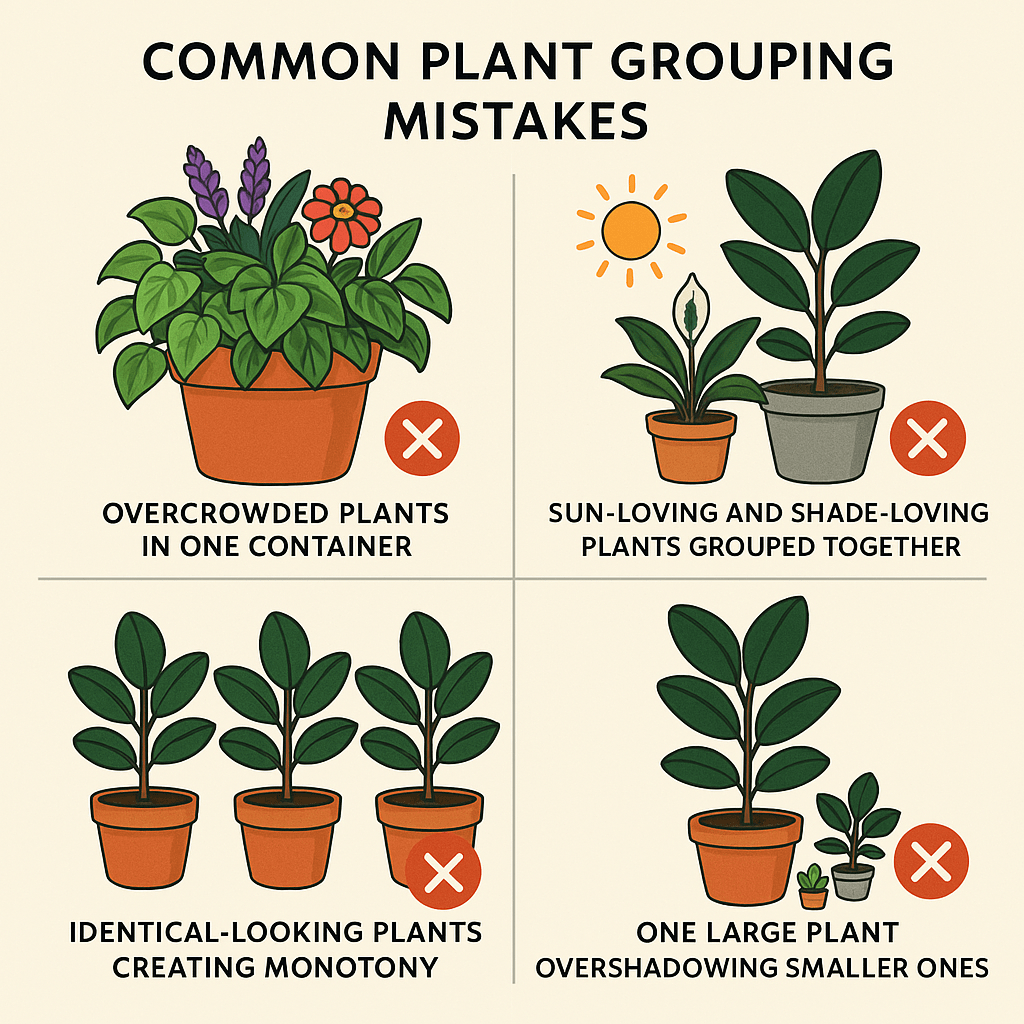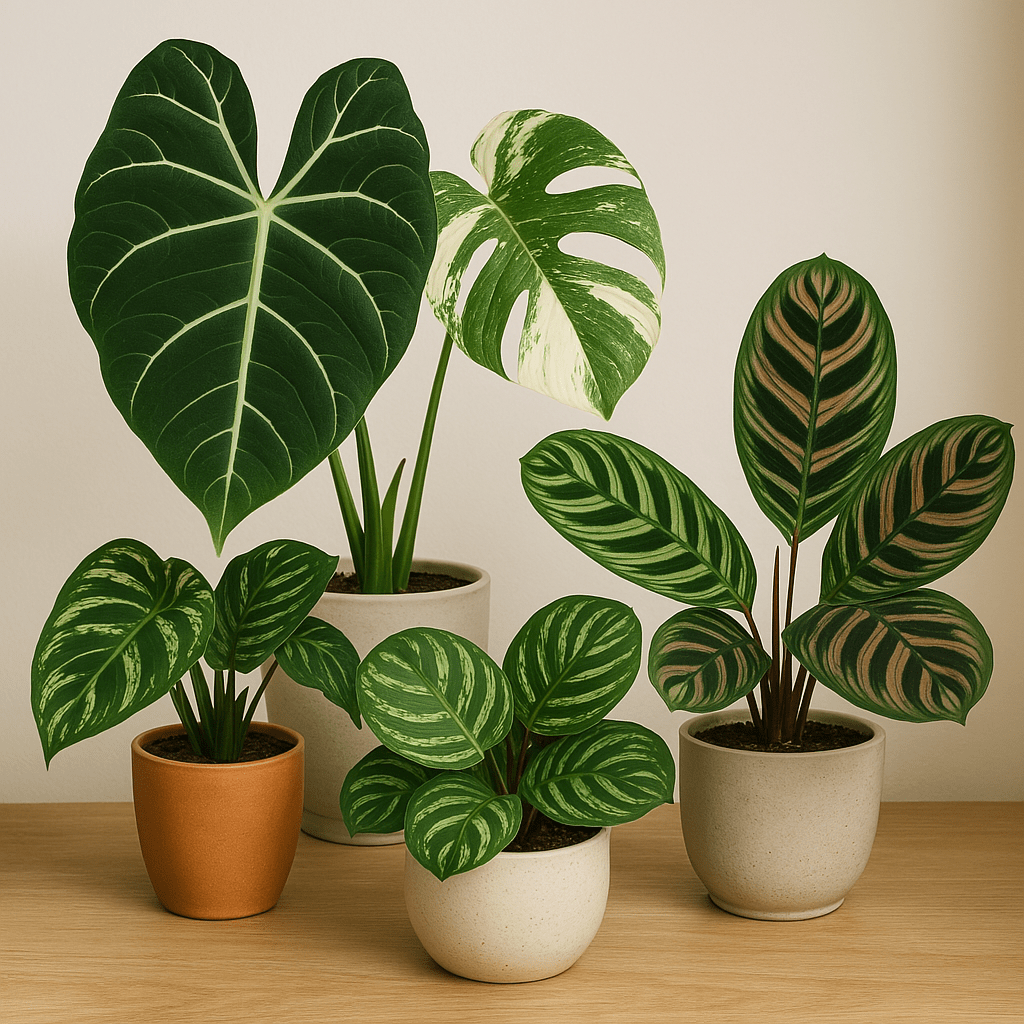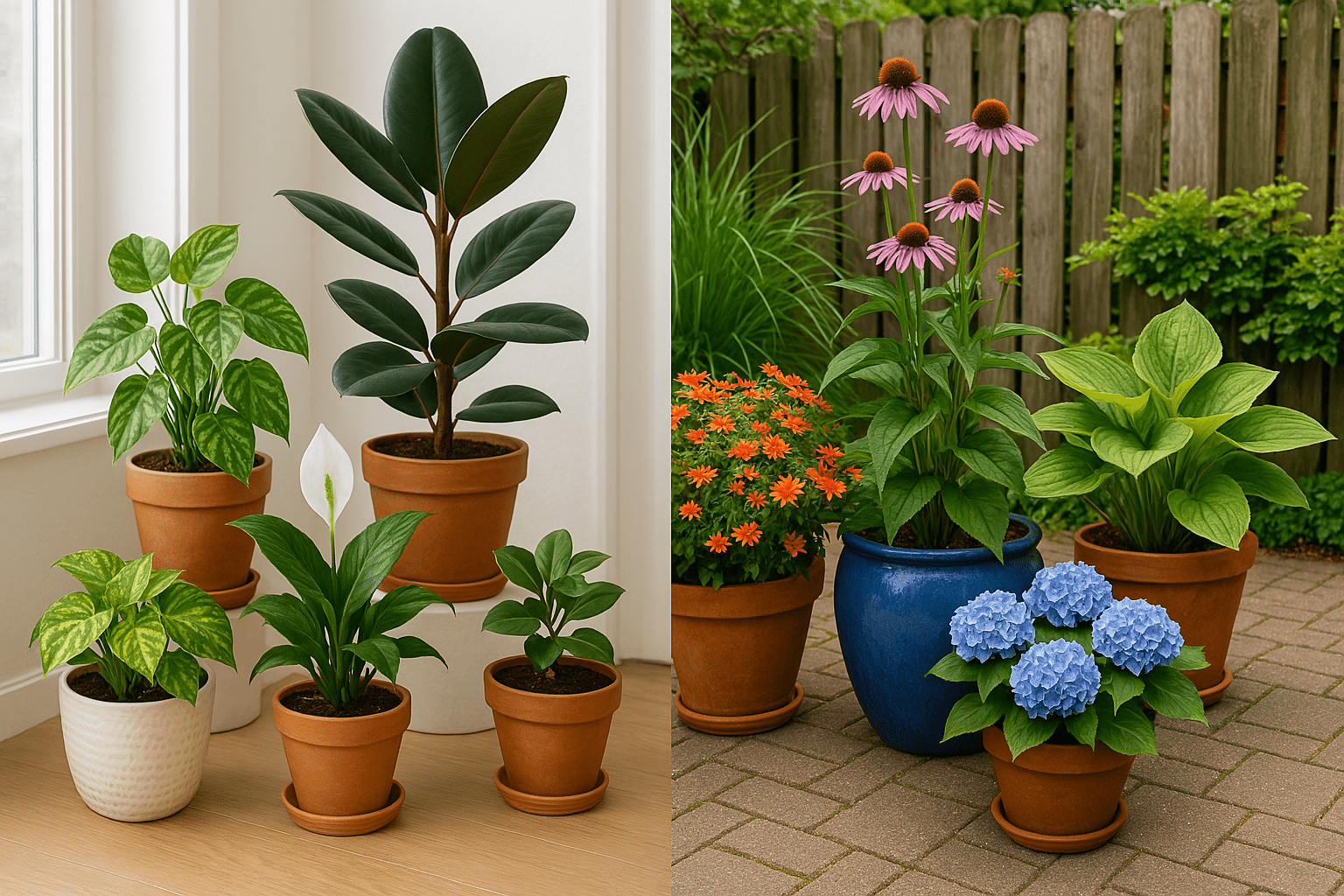
How to Group Plants for Visual Impact: Easy Tips for Creating Stunning Plant Displays
Are you looking to transform your space into a lush, visually stunning oasis? One of the easiest and most effective ways to do so is by learning how to group plants for visual impact. The right plant arrangement can bring depth, texture, and vibrancy to any room or garden. Whether you’re a seasoned plant parent or just starting out, understanding the basics of plant grouping can completely change the atmosphere of your home or outdoor space. In this article, we’ll share simple tips and tricks to help you create stunning plant displays that will make your space shine.
Table of Contents
ToggleWhy Grouping Plants Matters for Visual Impact 🌱✨
Grouping plants together is more than just a way to organize them—it’s a powerful technique for creating visual interest and enhancing the beauty of your space. Here’s why it matters:
- Aesthetic Appeal 🌿: When plants are grouped thoughtfully, they create depth and dimension, transforming any space into a vibrant display. Mixing different plant shapes, sizes, and colors adds texture and richness, making your setup look fuller and more dynamic.
- Balance and Harmony ⚖️: Grouping plants in the right way brings balance to a room or garden. For example, pairing tall plants with smaller ones creates visual stability, while different textures (like smooth leaves next to spiky ones) keep things interesting without feeling chaotic.
- Focal Points 🎯: Strategically placed plant groupings can become focal points in a room or garden, drawing the eye and giving the space a clear visual center. It’s a great way to highlight a particular area or create a stunning feature in your home.
- Practical Benefits 🌸: Beyond the aesthetic value, grouping plants also makes maintenance easier. You can group plants with similar care needs, making watering and light management more efficient. Plus, it can help plants thrive by protecting them from harsh conditions.

By mastering how to group plants for visual impact, you’ll not only improve the look of your space but also make your plants happier and healthier!
Basic Principles of Grouping Plants 🌿🎨
To create eye-catching plant displays, it’s essential to follow some key principles that can help you achieve the perfect balance and style. Here’s what you need to know:
- Varying Heights and Sizes 📏: Mixing plants of different heights adds depth and dimension. Tall plants placed at the back with shorter ones in the front create a layered effect, making your display look fuller and more dynamic. Think of it as creating a natural landscape—variety is key!
- Color Contrast and Coordination 🎨: Pair plants with complementary or contrasting colors for a striking visual impact. Bright greens next to deep reds or silvers next to purples can create an exciting, lively display. Just be mindful not to overdo it—balance is important!
- Leaf Texture and Shape 🍃: Combining plants with different leaf textures (e.g., smooth, fuzzy, or spiky) creates visual interest. A mix of large, broad leaves with small, delicate ones keeps your display from looking monotonous. Play with shapes to add variety and movement.

- Using Odd Numbers 3️⃣: Grouping plants in odd numbers, like 3 or 5, often looks more natural and visually appealing. Odd-numbered groupings create a sense of flow and avoid a rigid or symmetrical look, making your plant arrangements feel organic and balanced.
By following these simple yet effective principles, you’ll be able to create plant groupings that not only look beautiful but also feel harmonious and full of life! 🌱
Tips for Arranging Plants for Maximum Visual Impact 🌿🌟
Now that you understand the basics, let’s dive into some practical tips that will take your plant displays to the next level!
- Layering Plants 🏞️: Create a sense of depth by arranging plants in layers. Place taller plants at the back and smaller ones in the front. You can even add a few plants at varying heights on shelves or tables to build a more dynamic look. Layering gives your arrangement a natural flow, just like a garden in the wild.
- Use of Containers 🪴: Choose containers that complement your plants. The right pots and planters can enhance the visual impact. For example, sleek, modern pots work well with minimalistic plants, while rustic terracotta pots pair beautifully with more textured plants. Don’t be afraid to mix different container styles for added interest!
- Creating a Theme or Mood 🎭: Think about the atmosphere you want to create. Want a tropical feel? Group together lush, large-leaf plants like ferns and palms. For a more serene vibe, opt for succulents and cacti in neutral-toned pots. A well-chosen theme will make your plant grouping feel intentional and cohesive.
- Consider Lighting Needs ☀️: Different plants have different lighting requirements, so be sure to group plants with similar light preferences together. Place sun-loving plants in bright spots and shade-loving ones in low-light areas. This will keep your plants healthy and ensure their beauty is maintained in the long run.

By applying these tips, you can create plant arrangements that not only look beautiful but also thrive in your space. Happy arranging! 🌱
Indoor vs. Outdoor Plant Grouping 🌱🏡
Whether you’re arranging plants indoors or outdoors, the principles of grouping remain similar, but the environment plays a big role in how you approach your displays. Here’s a breakdown of key differences and tips for both:
Indoor Grouping Tips 🌟
- Space Considerations 🏠: Indoor spaces are often smaller, so make the most of your available area. Use shelves, plant stands, or window sills to maximize space. Group plants in corners or along walls to avoid clutter while still creating a lush look.
- Lighting Needs 💡: Indoor lighting can be tricky, with different rooms offering varying light levels. Place sun-loving plants near windows or on light shelves, while low-light plants like snake plants or pothos will thrive in shadier spots. Group plants with similar light needs to keep them happy.
- Humidity and Temperature 🌬️: Indoor climates can be dry, especially in winter. To help boost humidity, group tropical plants together, as they’ll create a microclimate that retains moisture. Consider using humidifiers or pebble trays for added humidity if necessary.
Outdoor Grouping Tips 🌳
- Seasonal Considerations 🌸: Outdoor plant arrangements are more affected by seasons. Group plants based on their bloom times, so you always have something in season. For example, mix spring bulbs with summer perennials to ensure your display remains colorful all year round.
- Climate and Weather 🌞🌧️: Outdoor plants need to be arranged with climate and weather conditions in mind. Group plants based on their hardiness and tolerance to weather extremes. Place delicate plants in sheltered spots and tough, hardy ones in direct sunlight or windier areas.
- Creating Outdoor Focal Points 🎯: For patios or gardens, use groupings to create focal points—think of a collection of vibrant flowers, large leafy plants, or a small succulent garden. Group plants by height, color, and texture to create a captivating outdoor display.
Whether indoors or outdoors, thoughtful plant grouping will bring beauty and harmony to your space while ensuring your plants stay healthy and happy. 🌿
Common Grouping Mistakes to Avoid ❌🌿
Even the most experienced plant lovers can make a few common mistakes when grouping plants. Here’s what to watch out for, so you can create the most stunning displays:
- Overcrowding Plants 🚫: It’s tempting to add more plants, but cramming too many together can make your display look cluttered and chaotic. Plants need space to breathe and grow. Ensure each plant has enough room for its roots to expand and that it’s not competing for light or water with its neighbors.
- Ignoring Light and Water Needs 💧🌞: Grouping plants with vastly different light and water requirements is a big no-no! Sun-loving plants should be placed in bright spots, while low-light plants like ferns should be kept in shaded areas. Similarly, make sure plants with similar watering needs are grouped together to prevent over or underwatering.
- Not Considering Growth 🌱: Plants grow! Don’t group plants that will outgrow their space or overshadow smaller plants. Consider the mature size of each plant before grouping them. For example, a small succulent will eventually be overshadowed by a rapidly growing fern, so place them accordingly.
- Too Much of the Same 🌿: While it’s tempting to group plants with similar looks, too many of the same type can make your display feel monotonous. Mix things up by including different textures, shapes, and sizes. A good variety adds depth and visual interest.
- Neglecting Seasonal Changes 🍂🌼: Plants can change with the seasons, and so should your groupings. If you’re grouping outdoor plants, be mindful of how they’ll look throughout the year. Some plants may go dormant in winter, while others will bloom in spring. Update your arrangements to match the seasons!

By avoiding these common mistakes, you’ll ensure your plant displays stay healthy, balanced, and visually stunning for months to come! 🌿✨
Creative Grouping Ideas 🌱🎨
Ready to take your plant arrangements to the next level? Here are some fun and creative ideas to inspire your plant groupings and make your space truly unique:
- Vertical Gardens 🏢
Create an eye-catching display by grouping plants vertically. Use plant shelves, hanging baskets, or wall-mounted planters to stack plants at varying heights. This not only saves space but also adds a dynamic, layered look to your space. Ideal for small rooms or apartments!
- Edible or Medicinal Plant Groupings 🌿🍅
Why not make your plant display functional? Group herbs like basil, mint, and thyme together in a sunny spot, or mix edible flowers like nasturtiums with veggies. This not only creates a beautiful display but also gives you fresh ingredients for your meals!
- Succulent Garden 🌵
Succulents are low-maintenance and come in a variety of shapes, sizes, and colors, making them perfect for creative groupings. Try creating a succulent garden in a shallow dish or tray. Mix them with different textures, like spiky cacti and smooth, round succulents, for a visually intriguing arrangement.
- Foliage Focus 🍃
Instead of flowers, focus on the beauty of plant foliage. Group plants with interesting leaves—like the dramatic elephant ear or the variegated monstera—together for a lush, green display. You can even mix different shades of green for a monochromatic yet stunning look.
- Themed Groupings 🎭
Create a theme for your plant arrangement! Go for a tropical theme with ferns, palms, and orchids, or try a desert theme with cacti and succulents. A themed display will bring cohesion and character to your space. Plus, it’s a fun way to experiment with plants from similar climates.
- Seasonal Displays 🍂🌷
Group plants based on the season to keep your space fresh throughout the year. In spring, try grouping vibrant flowers like tulips, daffodils, and pansies. For winter, evergreen plants or poinsettias can create a cozy, festive feel. Updating your plant groupings as the seasons change keeps your space exciting!

By getting creative with how you group your plants, you’ll not only create beautiful displays but also add personality and style to your space. Don’t be afraid to experiment and let your plants’ natural beauty shine! 🌿✨
Final Tips for Success 🌿🌟
To ensure your plant groupings not only look amazing but thrive, here are some final tips to help you achieve plant display success:
- Keep It Simple ✨
While it’s tempting to overcrowd with plants, simplicity often leads to the most striking results. Focus on quality over quantity—select a few plants that complement each other in size, texture, and color. A clean, curated look will have more visual impact than a chaotic arrangement.
- Rotate and Refresh 🔄
Plants grow and evolve, so don’t be afraid to rotate or refresh your groupings. Periodically move plants to different spots or swap them out with new ones to maintain a dynamic and ever-changing display. It’s an easy way to keep things exciting without starting from scratch.
- Consider Plant Care 💧🌞
Group plants with similar care needs—whether it’s water, light, or humidity—to make maintenance easier. When plants are grouped according to their needs, you’ll find it much easier to care for them and ensure they thrive together.
- Plan for Growth 📏
When grouping plants, always consider how they will grow over time. Some plants may need to be relocated as they get larger or as seasons change. Planning ahead helps avoid overcrowding or having to rearrange too often.
- Have Fun 🎉
Finally, don’t be afraid to have fun with your plant displays! Experiment with different combinations, styles, and arrangements. Let your creativity shine, and enjoy the process of bringing life to your space with beautiful plant groupings.

With these tips, you’ll create plant displays that are not only visually stunning but also practical and long-lasting. Happy grouping! 🌱
Learning how to group plants for visual impact is a fun and rewarding way to elevate your space, whether indoors or outdoors. By following the basic principles, avoiding common mistakes, and experimenting with creative groupings, you can create beautiful plant displays that reflect your personal style and make your plants thrive. Remember, the key to success lies in thoughtful arrangement, paying attention to each plant’s unique needs, and embracing your creativity. So, go ahead—start grouping your plants and watch your space come to life with vibrant color, texture, and energy! 🌱✨
Frequently Asked Questions (FAQ)
Why is grouping plants a good idea for home décor?
Grouping plants creates a fuller, more dramatic effect and adds texture, depth, and greenery to any space.
What types of plants work well together in a group?
Plants with similar light and watering needs work best—combine various heights, colors, and leaf shapes for contrast.
How many plants should I group together?
Three to five plants usually work well; odd numbers often look more natural and balanced in displays.
Should I use matching pots when grouping plants?
You can use matching pots for a uniform look or mix textures and colors for an eclectic, layered vibe.
Where should I place grouped plant displays?
Corners, window sills, coffee tables, shelves, and empty floor space near furniture are perfect for grouped arrangements.
How do I create height variation in plant groups?
Use plant stands, hanging pots, stackable crates, or choose plants with naturally different growth habits.
Can I group hanging and floor plants together?
Yes, combining hanging plants with tall and trailing floor plants adds dimension and keeps the eye moving upward.
What lighting should grouped plants have?
Place them where they all receive appropriate light based on their needs, or supplement with grow lights if needed.

